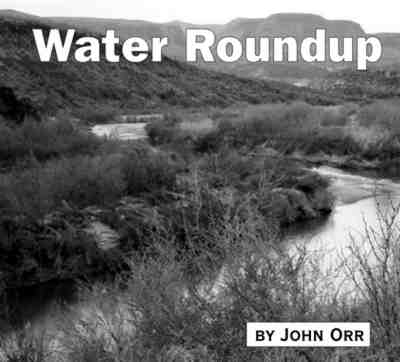Article by John Orr
Water – November 2008 – Colorado Central Magazine
Drought management and climate risk
In October Governor Ritter hosted the “Governor’s Conference on Managing Drought and Climate Risk” in Denver. According to the Rocky Mountain News, attendees were treated to information on historical droughts along with predictions about the effects of climate change on future water supplies.
Governor Ritter kicked things off. “We must be careful stewards of Colorado’s water supply. If we fail, we fail at the peril of our children and our grandchildren,” he said.

The assumption is that planning will help solve the needs for water for a few million additional Coloradans; the population is expected to double by 2050.
The Director of the Colorado Water Conservation Board, Jennifer Gimbel, told the group that planning is incomplete across the state. Most large water suppliers have a drought plan in place but some do not. She said that the state needs to help smaller suppliers learn to plan. “The law requires filing plans, but the law has no teeth,” said Gimbel. Utilities and systems that use more than 2,000 acre feet per year are required to file conservation plans with the state. Regulators are seeing approximately 25% compliance.
Much of the discussion was centered around a new report from the Western Water Assessment effort at Colorado University and the CWCB titled, “Climate Change in Colorado: A Synthesis to Support Water Resources Management and Adaptation.” The report is available at http://cwcb.state.co.usc.
According to the report, Coloradans can expect hotter summers, “as warm, or warmer than the hottest 10% of summers between 1950 and 1999.” Spring runoff is expected to arrive earlier in the year. They predict that annual precipitation will stay roughly equivalent to historical averages but that temperature increases will have an impact on supplies.
State officials have rolled climate change predictions into the Statewide Water Supply Initiative. In 2004 SWSI predicted an 18% gap between municipal supplies and available water. Much of the gap comes from depleted groundwater resources in high growth areas of the state.
A best guess right now is that climate change will reduce streamflows in the Colorado River Basin by 6-20%. However, the Pueblo Chieftain quoted Department of Natural Resources Executive Director Harris Sherman, “Our traditional assessment about the amount, form and location of precipitation has become a moving target.”
Alamosa water system
In October the Alamosa City Council passed an ordinance that will govern cross connections to the water supply system in order to prevent backflows into the system.
Backflow prevention devices are required under state and federal regulations, but Alamosa didn’t have a way to enforce them. Therefore the ordinance was recommended by the state. And city officials have been assisting customers with the installation of the devices since spring.
An exact cause of the outbreak is still unknown. However, the prime suspect is the Weber Reservoir which has been taken out of the potable water service chain.
Meanwhile, the city has inked a consent order with the Colorado Department of Health and Environment that prescribes water testing, monitoring and chlorination requirements. According to the Pueblo Chieftain, Public Works director Don Koskelin reassured residents, saying, “There is absolutely no question that the steps that are included in this consent order are minimum steps we would take with or without a consent order.”
Short takes
The new Fairplay wastewater treatment plant should be good to go on December 1st.
District Judge David Thorson has ruled in favor of eastern Frémont County joining the Upper Arkansas Water Conservancy District. The ruling was in response to a challenge to last fall’s election. Plaintiffs claimed that the election didn’t follow TABOR rules. Commissioner Mike Stiehl said, “From Pueblo on up, we will all speak with one voice and we will better be able to resist those whose entities would take our water,” reported the Cañon City Daily Record.
The Front Range Water Council was out in force at the Colorado River District’s annual water seminar in Grand Junction. Eric Wilkinson from the Northern Colorado Water Conservancy District told Coloradans from the exporting river basins that the FRWC, “would like to see the state rethink how much water it provides for fish and kayakers.” That would be the same fish and kayakers (and rafters) that annually bring millions in recreation dollars to central Colorado.
The Colorado Water Conservation board now has $1.5 million annually to spend on water rights. The funds will help the state preserve streamflows to help relieve the suffering of fish and wildlife in critical river systems.
Folks are keeping a close eye on the two new proposed reservoirs and water use plans at the Lucky Jack mine near Crested Butte. Statements of opposition were filed in October by the Crested Butte Land Trust, the High Country Citizens Alliance and the Trapper’s Crossing subdivision. As reported in The Crested Butte News, Crested Butte Land Trust Director Ann Johnston said, “This is in no way a political statement. We just want to be kept in the loop and want to protect our water rights and wetlands.”
Congratulations to the Project 7 Water Authority in the Uncompaghre Valley for placing second in a taste test at the recent American Water Works meeting in Colorado Springs. Winner, Denver Water, and second place Loveland both use transmountain water in their systems so they should have been handicapped.
Keep your eyes open for the draft environmental impact statement for the Aspinall Unit. Reclamation is charged with operating water projects to avoid adverse impact on endangered species and they’re also supposed to meet the project goals set out in enabling legislation. The EIS is exploring release alternatives to assist in meeting flow recommendations. www.usbr.gov/uc/wcao/rm/aspeis.
The various transmountain straws have moved around 190,000 acre-feet of water in the Arkansas River Basin this year. Aurora managed to move 15,000 acre-feet out of the basin through the Homestake Project. Colorado Springs has used about 70,000 acre-feet so far: 21,000 from the Fryingpan-Arkansas Project; 32,000 acre-feet through Twin Lakes; 10,700 acre-feet through Homestake; and 10,700 acre-feet from the Blue River system via Montgomery Reservoir in the South Platte Basin. Pueblo received 15,000 acre-feet through Twin Lakes.
Be sure to head over to Fort Collins on November 17th for the “GIS for Ditch Companies” workshop hosted by the Ditch and Reservoir Company Alliance. They’re schooling ditch managers on methods to apply Geographical Information Systems to ditch management. www.darca.org
More bad news on the zebra/quagga mussel front. Quagga veligers (the larval stage) have been found in Tarryall Reservoir, according to the Colorado Department of Wildlife.
In September the Colorado Water Conservation Board approved nearly $1.2 million for four projects in the San Luis Valley. The money is targeted for improvements at Continental Reservoir and Platoro Reservoir and for stream bank repairs for 12 miles of the Rio Grande in Alamosa County. Money was also allocated to reconstruct a ditch diversion on the Conejos River.
John Orr follows Colorado water and related issues at Coyote Gulch.


